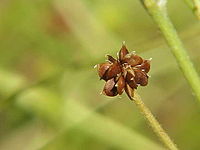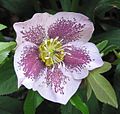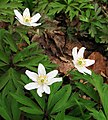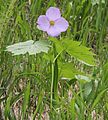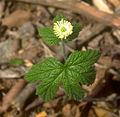Ranunculaceae
| Ranunculaceae | |
|---|---|

| |
| Ranunculus auricomus | |
| Scientific classification | |
| Kingdom: | Plantae |
| Clade: | Tracheophytes |
| Clade: | Angiosperms |
| Clade: | Eudicots |
| Order: | Ranunculales |
| Family: | Ranunculaceae Juss. |
| Type genus | |
| Ranunculus | |
| Subfamilies | |
| |
Ranunculaceae (/rənʌŋkjuːˈleɪsiˌaɪ, -siːˌiː/, buttercup or crowfoot family; Latin rānunculus "little frog", from rāna "frog") is a family of over 2,000 known species of flowering plants in 43 genera,[2] distributed worldwide.
The largest genera are Ranunculus (600 species), Delphinium (365), Thalictrum (330), Clematis (380), and Aconitum (300).
Description

Ranunculaceae are mostly
Most members of the family have
In some genera, such as
The fruits are most commonly free, unfused achenes (e.g. Ranunculus, Clematis) or follicles (e.g. Helleborus, Eranthis, Nigella), but a berry in Actaea.[3][4]
Phytochemistry
Ranunculaceae contain protoanemonin, which is toxic to humans and animals. Contact with plant sap may cause inflammation and blistering of the skin, while ingestion can cause irritation of the mouth, vomiting, and diarrhea.[11] Other poisonous or toxic compounds, alkaloids and glycosides, are also common.[citation needed]
Taxonomy
Takhtajan (1997) included the Ranunculaceae as the only family in the Ranunculales which he placed in a subclass, the Ranunculidae, instead of a superorder. Previously, Thorn (1992) placed the Ranunculaceae in the Berberidales, an order within the Superorder Magnolianae. Earlier Cronquist in 1981 included the Ranunculaceae along with seven other families in the Rancunculales which was included in the Magnoliidae, which he regarded as a subclass.
The family Ranunculaceae
Subdivision
Early subdivisions of the family, such as
- Helleboroideae
- Ranunculoideae
- Isopyroideae
- Thalictroideae
- Coptidoideae
- Hydrastidoideae
but by 1988 he had reduced Coptidoideae to a tribe within Isopyroideae, leaving five subfamilies, an arrangement he continued in his 1993 monograph, dividing the larger subfamilies into tribes, though by then
Tamura's complete system was structured as follows;
- Subfamilies and tribes
- Subfamily Ranunculoideae Hutch.
- Adonideae Kunth
- Anemoneae DC.
- Ranunculeae DC.
- Subfamily Helleboroideae Hutch.
- HelleboreaeDC.
- Cimicifugeae Torrey & A.Gray
- Delphineae Schrödinger
- Nigelleae Schrödinger
- Subfamily Isopyroideae Tamura
- Coptideae Langlet ex Tamura & K.Kosuge
- Dichocarpeae Tamura & K.Kosuge
- Isopyreae Schrödinger
- Subfamily Thalictroideae
- Subfamily Hydrastidoideae
The genus
Molecular phylogenetics
When subjected to
The relationships between the genera suggest the existence of three major
In addition to the two monotypic subgenera, Coptoideae has 17 species and Thalictroideae has 450, including Thalictrum and Aquilegia. The other genera (2025 species, 81% of the family) belong to Ranunculoideae. Kingdonia had been included by Tamura in Anemoneae, but is now added to Circaeasteraceae.
In recent years, researchers have used nuclear genes (obtained through transcriptome sequencing technology) to further investigate the phylogenetic relationships of the Ranunculaceae family, and their findings are consistent with those of Wang and colleagues (2009). However, this study indicates that the ancestors of the Ranunculaceae family experienced multiple whole-genome duplication (WGD) events, which may be related to the longstanding prosperity of this ancient group.[19]
- Subfamilies of Ranunculaceae (5) and tribes of Ranunculoideae
- Glaucidioideae(Tamura) Loconte (1)
- HydrastidoideaeEngler (1)
- Coptidoideae Tamura (2)
- Thalictroideae Raf. (10)
- Ranunculoideae Arn. (46)
- Adonideae Kunth
- Delphinieae Schröd.
- Nigelleae Schröd.
- Helleboreae DC.
- Cimicifugeae Torr. and A.Gray
- Caltheae Bercht. and J.Presl
- Asteropyreae W.T.Wang and C. Y.Chang
- Callianthemeae W.Wang and Z. D.Chen
- Anemoneae DC.
- Ranunculeae DC.
| Cladogram of Ranunculaceae subfamilies[15] |
Genera
Ranunculaceae contains approximately 43 genera.[2][20]
- Subfamily Glaucidioideae
- GlaucidiumSiebold & Zuccarini
- Subfamily Hydrastidoideae
- Hydrastis L.
- Subfamily Coptidoideae
- Coptis Salisb.
- Xanthorhiza Marshall
- Subfamily Thalictroideae
- Aquilegia L.
- Dichocarpum W.T.Wang & P.K.Hsiao
- Enemion Rafinesque
- Isopyrum L.
- Leptopyrum Reichenbach
- Paraquilegia J.R.Drumm. & Hutch.
- Semiaquilegia Makino
- Thalictrum L.
- Urophysa Ulbr.
- Subfamily Ranunculoideae
- Tribe Adonideae
- Adonis L.
- Calathodes Hook.f. & Thomson
- Megaleranthis Ohwi
- Trollius L.
- Tribe Delphinieae
- Aconitum L.
- Consolida Gray
- Gymnaconitum (Stapf) Wei Wang & Z.D.Chen
- Delphinium L.
- Staphisagria Hill
- Tribe Nigelleae
- Nigella L.
- Tribe Helleboreae
- Helleborus L.
- Tribe Cimicifugeae
- Actaea L.
- Anemonopsis Siebold & Zuccarini
- Beesia Balf.f. & W.W.Sm.
- CimicifugaWernisch.
- Eranthis Salisb.
- Tribe Caltheae
- Caltha L.
- Tribe Asteropyreae
- Asteropyrum J.R.Drumm. & Hutch.
- Tribe Callianthemeae
- Callianthemum C.A.Mey.
- Tribe Anemoneae
- Anemoclema(Franch.) W.T.Wang
- AnemonastrumHolub
- Anemone L.
- Anemonoides Mill.
- Clematis L.
- Eriocapitella Nakai
- Hepatica Mill.
- Knowltonia Salisb.
- Metanemone W.T.Wang
- Adans.
- Pulsatilla Mill.
- Tribe Ranunculeae
- Arcteranthis Greene
- Beckwithia Jeps.
- Callianthemoides Tamura
- Ceratocephala Moench
- Coptidium (Prantl) Á.Löve & D.Löve ex Tzvelev
- Cyrtorhyncha Nutt.
- Ficaria Guett.
- Halerpestes Greene
- Hamadryas Comm. ex Juss.
- Krapfia DC.
- Kumlienia Greene
- Laccopetalum Ulbr.
- Myosurus L.
- Oxygraphis Bunge
- Paroxygraphis W.W.Sm.
- Peltocalathos Tamura
- Ranunculus L.
- Trautvetteria Fisch. & C.A.Mey.
Previous genera
- Anemonella Spach → Thalictrum
- Psychrophila (DC.) Bercht. & J.Presl → Caltha
Fossil record
Contrary to earlier data, there are no confirmed pre-Tertiary ranunculacean fossils.[21] The Early Cretaceous Leefructus mirus from the Yixian Formation in China was described as belonging to the "compare Family stem lineage to the Ranunculaceae".[22] The oldest confirmed representative of the family is Paleoactaea nagelii Pigg & DeVore described on the basis of fruits coming from the Upper Paleocene of North Dakota.[1]
Uses
Some Ranunculaceae are used as
Gallery
Tribes of subfamily Ranunculoideae
-
Adonideae:
Adonis annua -
Delphinieae:
Delphinium elatum hybrid -
Nigelleae:
Nigella damascena -
Helleboreae:Helleborus× hybridus
-
Cimicifugeae:
Actaea simplex -
Caltheae:
Caltha palustris -
Callianthemeae:
Callianthemum hondoense -
Anemoneae:Anemone nemorosa
-
Ranunculeae:
Ranunculus auricomus
Other subfamilies
-
Coptidoideae:
Coptis trifolia -
Glaucidioideae:
Glaucidium palmatum -
Hydrastidoideae:Hydrastis canadensis
-
Thalictroideae:
Thalictrum delavayi -
Thalictroideae:
Aquilegia vulgaris -
Thalictroideae:
Isopyrum thalictroides
Notes
References
- ^ a b Pigg & DeVore 2005.
- ^ a b Christenhusz & Byng 2016.
- ^ a b c d Clapham, Tutin & Warburg 1981.
- ^ a b c Stace 2010.
- ^ a b Ronse de Craene 2010.
- ^ a b FNA
- ^ Tamura 1993, p. 564.
- . Retrieved 6 December 2018.
- ^ Ross, Gary (22 December 2016). "Treat Your Bees to a Banquet of Poppies". Bee Culture. A.I. Root Company. Retrieved 6 December 2018.
- S2CID 16275166. Retrieved 6 December 2018.
- ^ "Anemone (Windflower) | North Carolina Extension Gardener Plant Toolbox". plants.ces.ncsu.edu. Retrieved 2021-02-17.
- ^ Flowering Plant Gateway
- ^ "Plants in their proper places – the new classification of flowering plants" (PDF). Royal Horticultural Society. Archived from the original (PDF) on 18 July 2011.
- ^ APG 2016.
- ^ a b c d Wang et al 2009.
- ^ Angiosperm Phylogeny poster
- ^ Tamura 1993.
- ^ Stevens 2017.
- .
- ^ The Plant List 2013, Ranunculaceae
- ISBN 978-0-521-59283-3.
- ^ Sun, Ge; Dilcher, David L.; Wang, Hongshang; Chen, Zhiduan. "A eudicot from the Early Cretaceous of China". Nature. 471 (7340): 625–628.
- ^ Turner 1984.
Bibliography
- Clapham, A.R.; Tutin, T.G.; Warburg, E.F. (1981). Excursion flora of the British Isles (3 ed.). Cambridge, U.K.: Cambridge University Press. ISBN 978-0521232906.: 25
- ISBN 9780521707725.: 101
- Ronse de Craene, L.P. (2010). Floral diagrams, an aid to understanding flower morphology and evolution. Cambridge University Press. ISBN 9780521729451.: 140
- .
- Langlet, O. (1932). Uber Chromosomenverhaltnisse und Systematik der Ranunculaceae. Svensk Bot. Tidskr 26, 381–401.
- .
- Keener, Carl S.; JSTOR 1224562.
- Kubitzki, Klaus; Rohwer, Jens G.; Bittrich, Volker, eds. (1993). The Families and Genera of Vascular Plants. II Flowering plants - Dicotyledons. Magnoliid, Hamamelid and Caryophyllid families. Berlin: Springer. ISBN 978-3540555094.
- ISBN 9783540555094., in Kubitzki et al (1993)
- Strasburger, Noll, Schenck, Schimper: Lehrbuch der Botanik für Hochschulen. 4. Auflage, Gustav Fischer, Jena 1900, p. 459 (flower diagrams)
- Pigg, K. B.; DeVore, M. L. (1 October 2005). "Paleoactaea gen. nov. (Ranunculaceae) fruits from the Paleogene of North Dakota and the London Clay". PMID 21646082.
- Stevens, P.F. (2017) [2001], Angiosperm Phylogeny Website, Missouri Botanical Garden, retrieved 13 April 2015
- Sandro Pignatti. Flora d'Italia, Edagricole, Bologna 1982.(in Italian) ISBN 88-506-2449-2
- Kumazawa, Masao (1938). "Systematic and Phylogenetic Consideration of the Ranunculaceae and Berberidaceae". Shokubutsugaku Zasshi. 52 (613): 9–15. .
- Emadzade, Khatere; Lehnebach, Carlos; Lockhart, Peter; Elvira, Hörandl (June 2010). "A molecular phylogeny, morphology and classification of genera of Ranunculeae (Ranunculaceae)" (PDF). .
- Wang, Wei; Lu, An-Ming; Ren, Yi; Endress, Mary E.; Chen, Zhi-Duan (January 2009). "Phylogeny and classification of Ranunculales: Evidence from four molecular loci and morphological data". Perspectives in Plant Ecology, Evolution and Systematics. 11 (2): 81–110. .
- Turner, NJ (July 1984). "Counter-irritant and other medicinal uses of plants in Ranunculaceae by native peoples in British Columbia and neighbouring areas". Journal of Ethnopharmacology. 11 (2): 181–201. PMID 6387285.
- Whittemore, Alan T.; Parfitt, Bruce D. (1997). "Ranunculaceae". In Flora of North America Editorial Committee (ed.). Flora of North America North of Mexico (FNA). Vol. 3. New York and Oxford: Oxford University Press – via eFloras.org, Missouri Botanical Garden, St. Louis, MO & Harvard University Herbaria, Cambridge, MA.
- The Plant List (2013). "The Plant List Version 1.1". Royal Botanic Gardens, Kew and Missouri Botanical Garden. Retrieved 7 July 2015.
External links
- Flora of North America: Ranunculaceae
- Flora of China: Ranunculaceae
- Ranunculaceae in Topwalks
- Ranunculaceae in BoDD – Botanical Dermatology Database
- Ranunculaceae in L. Watson and M.J. Dallwitz (1992 onwards). The families of flowering plants.
- NCBI Taxonomy Browser
- links at CSDL, Texas
- Japanese Ranunculaceae - Flavon's art gallery
- Family Ranunculaceae Flowers in Israel
- Cai et al. Molecular phylogeny of Ranunculaceae based on internal transcribed spacer sequences 2009
- Aconitum heterophyllum (fam. Ranunculaceae) at the Encyclopedia of Ayurvedic Medicinal Plants


